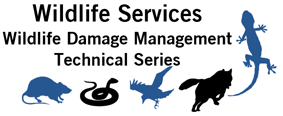United States Department of Agriculture: Animal and Plant Health Inspection Service

Wildlife Damage Management Technical Series
Date of this Version
7-2018
Document Type
Article
Citation
Vantassel, S.M. and M.A. King. 2018. Wildlife Carcass Disposal. Wildlife Damage Management Technical Series. USDA, APHIS, WS National Wildlife Research Center. Fort Collins, Colorado. 10p.
Abstract
Many wildlife management situations require the disposal of animal carcasses. These can include the lethal removal of wildlife to resolve damage or conflicts, as well as clean-up after mortalities caused by vehicle collisions, disease, oil spills (Figure 1) or other natural disasters. Carcasses must be disposed of properly to protect public sensitivities, the environment, and public health. Improper disposal of carcasses can result in public outrage, site contamination, injury to animals and people, and the attraction of other animals that may lead to wildlife damage issues. Concern over ground water contamination and disease transmission from improper carcass disposal has resulted in increased regulation. Successful carcass disposal programs are cost-effective, environmentally sound, and protective of public health. In addition, disposal practices must demonstrate sensitivity to public perception while adhering to state and local guidelines. This publication discusses the range of options available for the responsible disposal of animal carcasses.
Proper disposal of carcasses protects the sensitivities of the public, reduces the potential for the spread of zoonotic diseases, prevents nutrient losses to surrounding soils and ultimately, groundwater, and reduces human-wildlife conflicts. Failure to dispose of carcasses appropriately can cause unwanted media attention and public outrage. The overall goal of any animal carcass management plan is to ensure clean, safe disposal of all materials in a manner that protects human, animal, and environmental health.
Included in
Behavior and Ethology Commons, Biodiversity Commons, Other Animal Sciences Commons, Other Ecology and Evolutionary Biology Commons, Population Biology Commons, Terrestrial and Aquatic Ecology Commons


Comments
US government work.